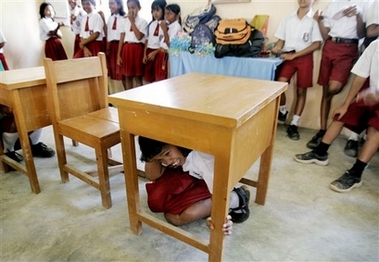Asia-Pacific
Indonesia fears another massive tsunami
(AP)
Updated: 2006-12-25 09:56
 |
Large Medium Small |
PADANG, Indonesia - Two years after an earthquake off western Indonesia unleashed a monster tsunami, scientists expect the same fault to rupture again within the next few decades — and this town stands to take the full force of the waves.
|
|
"All this area in red will disappear," Padang Mayor Fauzi Bahar said, pointing at a satellite map on his office wall showing the likely reach of the waves into the town.
The low-lying town of 900,000 people has started mapping out evacuation routes and educating the public, but all the same, authorities fear up to 60,000 will die, unable to outrun the waves even if they get a speedy warning and flee.
"The people will be washed away," Bahar said.
On the morning of Dec. 26, 2004, the most powerful earthquake in four decades lifted the seabed west of Sumatra by several yards, propelling waves up to two stories high at jetliner speeds across the Indian Ocean to smash into coastal communities, beach resorts and towns in 12 nations.
In hardest-hit Indonesia, Thailand, Sri Lanka and India, the waves surged miles inland, tossing ships, swallowing entire villages and leaving behind a blasted landscape of concrete foundations and rubble littered with tens of thousands of bodies.
On Sumatra island — home to more than half the tsunami's nearly 230,000 dead and missing — volunteers and emergency workers took three months to recover all the corpses and bury them in mass graves.
Warnings of another tsunami-spawning quake are adding urgency to efforts to establish a warning system covering the Indian Ocean rim like the network of high-tech buoys in the Pacific that alerts Japan, the United States and other nations of sudden tidal changes.
The worst-affected countries have begun installing sirens on threatened coasts and three buoys with sensors capable of detecting waves generated by seismic activity are in the water, but the network is several years from completion, officials say.
Making sure the system works from end-to-end is a "daunting task," said Curt Barrett at the US National Oceanic and Atmospheric Administration, which is helping set it up.
"Once the warning goes out, people have to know what to do," he said. "All of this information is useless if it doesn't get to the person down on the beach."
The warnings of another tsunami are based on more than a decade of research by respected US geologist Kerry Sieh and a team of scientists on a section of the fault just south of the part that ruptured in 2004.
| 分享按钮 |

